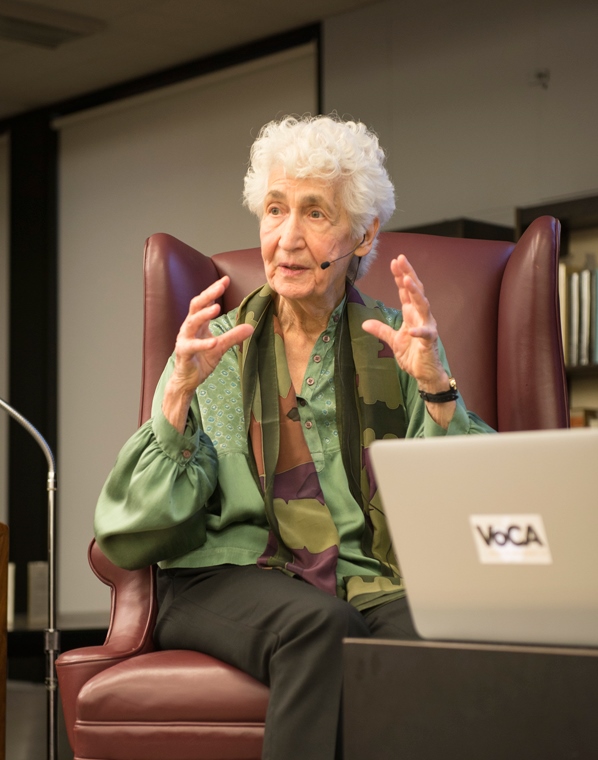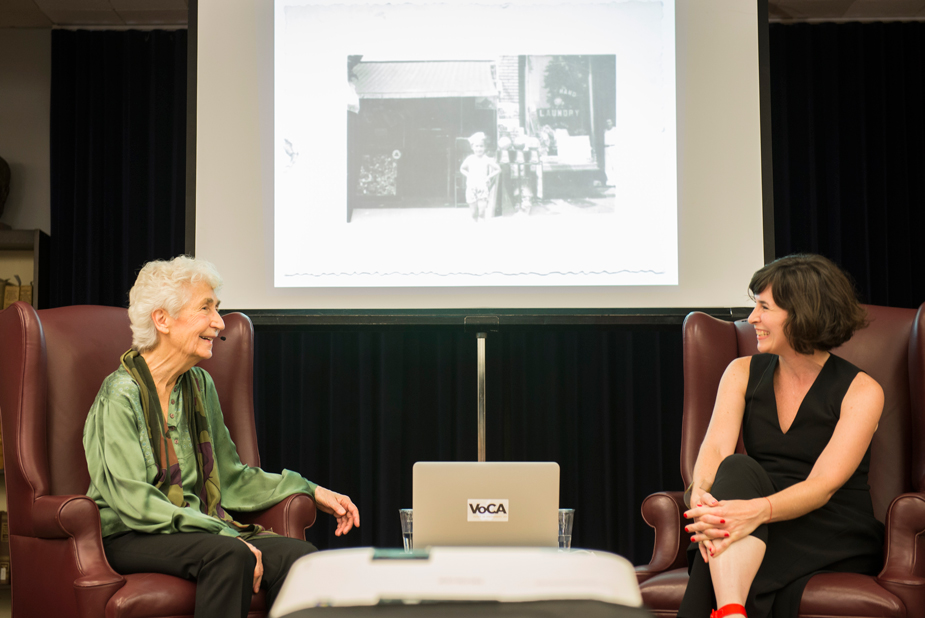This week’s contributing blogger, Alicia Ehni, is a multidisciplinary artist and the editor of the IAP Newsletter for New York Foundation for the Arts. Alicia interviews immigrant artists and administrators whose work has a direct impact on their community.

On September 14, 2017 artist Gwen Fabricant met with freelance conservator and VoCA Program Committee member Jennifer Hickey at the Fales Library to launch the third season of the on-going CALL/VoCA Talks series, hosted in partnership with the Joan Mitchell Foundation’s Creating a Living Legacy (CALL) Program. The discussion was lively and inspiring, and as the two speakers presented a series of images that mapped the chronological progress of Gwen’s career, Gwen shared stories of when and why each painting was created and explained the origin of each element that composed the canvas.
Gwen’s compositions of found objects and natural materials juxtapose different worlds, while in others the grid serves as support for a deep investigation of a single object. Her artistic practice is quite unique: Fabricant has borrowed bones from a university library, convinced a neighbor to let her borrow a skull, old textiles, and carpets; in the past, she has found salted fish in the market that she then boiled, using the leftover bony head as subject matter; she also uses family heirlooms, brass objects, fruits, and delicate flowers in her compositions. Looking at different series of paintings, we can see how many of these elements reappear, time and again. Serving as an excuse to investigate the form and it’s relationships to the light, as Fabricant says: “I’m interested in making that piece of reality my own, not to make it realistic but to make it translate it into paint as I see it.”
Fabricant shared photos of her childhood in East New York, making it clear that she already knew then that she wanted to be an artist, even though she didn’t know what exactly being an artist meant. She later studied art at Cooper Union and Brooklyn College and after graduation she entered the fields of academia and theater. For ten years she dedicated herself to teaching and working as costume designer for the Open Theater in Soho, New York. Reflecting on her time as an educator, Fabricant described it as a wonderful gift. She was a pioneer in her field which at that was a time was male-dominated; she worked full time and took care of her child, and dedicated the summers to painting.
During that time, Fabricant started to paint from nature, taking a plein air approach that was to be a very slow process. She would transport big canvases on top of her Volkswagen Beetle and head to the woods to paint for prolonged periods and then complete the work back at her studio. The resulting paintings from this period are highly skilled and realistic, evoking themes of the uncanny.
Having the artist narrate each piece brought insight into her creative process. She described her use of layering and translucency in the paint when approaching the complexity of flowers, as well as the challenges she endures to paint them before they collapse. “It took me a long time to think they are still life,” she said “because for me what’s important is the light.”
One series of particular interest was Fabricant’s Spore Prints, works that came about as the result of her frequent walks with the members from the New York Mycological Society. A woman from the audience asked Fabricant about the process and how she was able to get a particular color from the mushrooms. Fabricant, with great passion, explained how most of the mushrooms have gills and how the color of the spores reveal whether it is edible or poisonous: “You get beautiful white spores form the most deadly mushrooms,” she explained. But, regarding the resulting colors of the print, Fabricant gave full credit to nature and the mushrooms: “They are in charge, there is really very little I can add… I really think that they should sign the work.”
Fabricant’s CALL experience is a great example of why programs like this are extremely important and necessary beyond the aspect of preserving the legacy of an artist. Fabricant was emphatic in describing her engagement with CALL as a significant milestone in her artistic career, and spoke about the enrichment of working with younger artists, and how much she learned about advances in technology, tools, and current trends in art. In fact, she started using the scanner not only to document her work but as an integral component in her creative process. In her recent explorations, scanning and printing NASA images serves as a starting point for a new series of collage work. As a special treat that night we were able to see some of these collages in-person, on display in the front vitrines of Fales Library. I left the talk inspired and filled with wonder about Fabricant’s richly textured collages, and her ability to transport us into intricate cosmic fantasies.
A video of this program is available online at https://vimeo.com/261389481.



